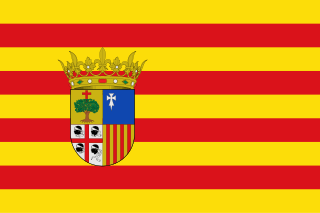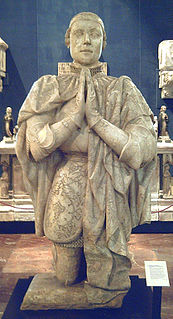
Peter, called the Cruel or the Just, was the king of Castile and León from 1350 to 1369. Peter was the last ruler of the main branch of the House of Ivrea.

Pedro González de Mendoza was a Spanish cardinal and statesman who served as Archbishop of Toledo (1482–1495), Archbishop of Sevilla (1474–1482), Bishop of Sigüenza (1467–1474), and Bishop of Calahorra y La Calzada (1453–1467).

Braga is a city and a municipality in the northwestern Portuguese district of Braga, in the historical and cultural Minho Province. The city has a resident population of 192,494 inhabitants, representing the seventh largest municipality in Portugal. Its area is 183.40 km². Its agglomerated urban area extends from the Cávado River to the Este River. It is the third-largest urban centre in Portugal

The Most Serene House of Braganza, or the Brigantine Dynasty, also known in the Empire of Brazil as the Most August House of Braganza is a dynasty of emperors, kings, princes, and dukes of Portuguese origin, a branch of the House of Aviz.

DomFerdinand II was a German prince of the House of Saxe-Coburg and Gotha-Koháry, and King of Portugal jure uxoris as the husband of Queen Maria II, from the birth of their son in 1837 to her death in 1853.

An Arabist is someone normally from outside the Arab world who specialises in the study of the Arabic language and culture.

Fernão Lopes was a Portuguese chronicler appointed by King Edward of Portugal. Fernão Lopes wrote the history of Portugal, but only a part of his work remained.

The real was the unit of currency of Portugal from around 1430 until 1911. It replaced the dinheiro at the rate of 1 real = 840 dinheiros and was itself replaced by the escudo at a rate of 1 escudo = 1000 réis. The escudo was further replaced by the euro at a rate of 1 euro = 200.482 escudos in 2002.
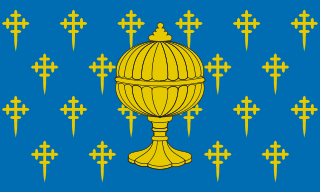
The Kingdom of Galicia was a political entity located in southwestern Europe, which at its territorial zenith occupied the entire northwest of the Iberian Peninsula. Founded by Suebic king Hermeric in 409, the Galician capital was established in Braga, being the first kingdom which adopted Catholicism officially and minted its own currency. It was part of the Kingdom of the Spanish Visigothic monarchs from 585 to 711. In the 8th century Galicia became a part of the newly founded Christian kingdoms of the Northwest of the peninsula, Asturias and León, while occasionally achieving independence under the authority of its own kings. Compostela became capital of Galicia in the 11th century, while the independence of Portugal (1128) determined its southern boundary. The accession of Castilian King Ferdinand III to the Leonese kingdom in 1230 brought Galicia under the control of the Crown of Castile, the kingdom of Galicia becoming a political division within the larger realm.

The Cathedral of Guarda is a Catholic church located in the northeastern city of Guarda, Portugal. Its construction took from 1390 until the mid 16th century, combining Gothic and Manueline architectural styles.
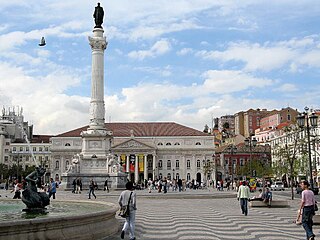
Rossio Square is the popular name of the Pedro IV Square in the city of Lisbon, in Portugal. It is located in the Pombaline Downtown of Lisbon and has been one of its main squares since the Middle Ages. It has been the setting of popular revolts and celebrations, bullfights and executions, and is now a preferred meeting place of Lisbon natives and tourists alike.

Sahagún is a town in the province of León, Spain. It is the main town of the Leonese section of the Tierra de Campos district.
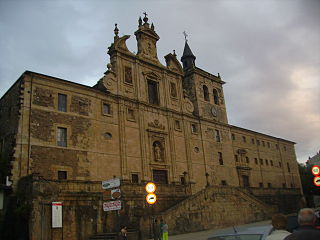
Vilafranca del Bierzo is a village and municipality located in the comarca of El Bierzo, in the province of León, Castile and León, Spain.
Mala District is one of sixteen districts of the province Cañete in Peru. It limits on the north with San Antonio District and Santa Cruz de Flores District that separates them the Mala river. To the south-east, the Coayllo District.

The Mendoza family was a powerful line of Spanish nobles. Members of the family wielded considerable power, especially from the 14th to the 17th centuries in Castile. The family originated from the town of Mendoza in the province of Álava in the Basque countries, with the seigneury becoming part of the Kingdom of Castile during the reign of Alfonso XI (1312–1350).

Pedro de Araújo Lima, Marquis of Olinda was a politician and monarchist of the Empire of Brazil. His long political career expanded through the reigns of João VI, Pedro I and Pedro II. He was also one of the founders of the Brazilian Conservative Party.
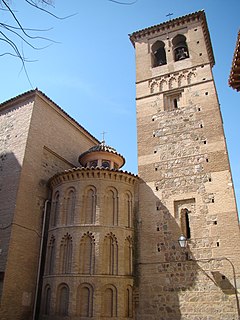
The Monastery of Saint Dominic of Silos is a Cistercian monastery in Toledo. It was first founded in the 6th century and rebuilt in 1085 by Pedro Alcocer during the reign of Alfonso VI of Leon and Castille. It underwent major rebuilding work in the second half of the 16th century, in which the mudéjar church was demolished. The new building was begun by Nicolás de Vergara and completed by the royal architect Juan de Herrera, as well as being provided with a new altarpiece by El Greco.
Pedro IV Nusamu a Mvemba. King of Kongo, ruled from 1695 to 1718, although his effective reign of Kongo was only from 1709. He is noted for restoring the country and ending the civil war which had raged since 1666. It was during his reign that Beatriz Kimpa Vita, the prophetess claimed to be possessed by Saint Anthony had her career.

Cuzcurrita de Río Tirón, known as Cuzcurrita is a village in the province and autonomous community of La Rioja, Spain. The municipality covers an area of 19.17 square kilometres (7.40 sq mi) and as of 2011 had a population of 544 people.

Peter V, nicknamed "the Hopeful", was King of Portugal from 1853 to 1861.
